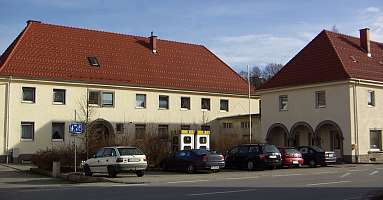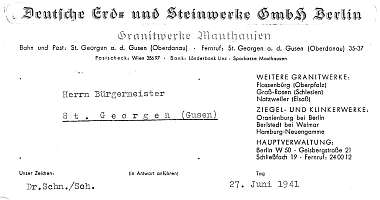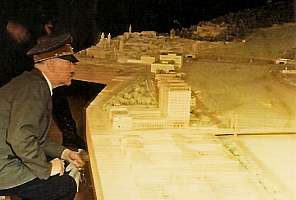German Earth and Stone Works (DEST)
This company (ger.: Deutsche Erd- und Steinwerke GmbH) was owned by the SS and was responsible for the exploitation of the inmates of KZ Mauthausen and KZ Gusen in stone-quarries, the construction of the camps, and the armament-projects starting in 1942.

The company was founded in Berlin on 29 April 1938 and took over the original stone-quarries in Mauthausen and Gusen just a few weeks after the annexation of Austria to the Third Reich on March 17, 1938. For this reason, Himmler and Pohl visited the stone-quarries of Mauthausen and Gusen in early 1938.
DEST also operated the brick manufacturing plants at Sachsenhausen and Buchenwald, and the stone-quarries at Flossenbuerg and Natzweiler, as well as Gross-Rosen where DEST also exploited concentration camp inmates to make some of the profits to finance the SS in general.

In 1939 DEST-Berlin decided to establish a new administrational complex at St. Georgen/Gusen – a town just a few Kilometers west of the KZ Mauthausen-Gusen complex.
Between 1940 and 1945 this administrational center was a key installation between the “Wirtschaftsverwaltungshauptamt (WHVA)” of the SS in Berlin and the slave work in the concentration camps of Mauthausen and Gusen.

In fact, the DEST stone-production complex at Mauthausen and Gusen developed into the most important one of DEST on Third Reich territory. Some 4,000 prisoners, led by some 250 civilian employees, produced up to 25,000 cubic-meters of cut granite stones a year. DEST was also very proud in those years to operate the biggest stone-crusher on the European continent at KZ Gusen.
In the period between 1939 and 1942, DEST was specialized in producing granite-stones – a good part of them for the construction of cities like Linz (nearby hometown of Adolf Hitler), Munich (capital of the Nazi-Party), Nuremberg (capital of the NS-Movement), Weimar, and Berlin. When the strategic war-scenario changed in 1942, DEST became a sub-contractor of leading German arms-production companies.
At first, DEST built a few more barracks at KZ Gusen to house maintenance work for the German Army (Wehrmacht) and built 18 barracks to produce parts of machine-guns and aircraft-engines for Steyr-Daimler-Puch AG with some extra 8.500 prisoners.
The principle was simple:
DEST provided
- the locations, prisoners, buildings, and other infra-structure.
The other companies provided
- know-how, machinery, and skilled workers.
The SS-Batallions provided
- security and the operation of the concentration-camps.
In 1943 DEST also begun manufacturing fuselages for the Messerschmitt Me-109 fighter-planes. During this period, some 20 fuselages and pairs of wings were produced by KZ Gusen inmates per day.
Then, in late 1943, when the U.S. strategic bombings devastated some key war-production facilities of the Third Reich, DEST started to provided huge tunnel-systems in the vicinity of KZ Gusen for its commercial partners.
At first, they have begun to dig the “KELLERBAU” tunnels to shelter the machine-gun production of Steyr-Daimler-Puch AG directly north of the KZ Gusen “GEORGEN-MUEHLE” (Steyr) Barracks.
Later on, a second, much bigger underground system was built in neighboring St. Georgen/Gusen (site of the regional DEST central administration) to shelter the production of Me-262 Messerschmitt airplanes in the “BERGKRISTALL-ESCHE 2" underground plant.
To manage this project, DEST established a new, second concentration camp at Gusen – Camp KZ Gusen II. This camp was only established “to manage” the thousands of new inmates sent to KZ Gusen to build the giant underground plant at nearby St.Georgen/Gusen.
With this latest KZ Gusen II (BERGKRISTALL) project, DEST became one of the leading sub-contractors of Messerschmitt GmbH.
So, at the end of WW2, nearly 1/3 of all the Messerschmitt aircraft-production was provided by DEST with the concentration camps at Gusen-Mauthausen and Flossenbuerg. KZ Gusen II (the Hell of Hells), was the key-installation within this network, because it was dedicated to the final assembly of the first serially-produced jet-propelled plane in history.
The company was led by the following officials:
Berlin
- SS-Obergruppenfuehrer Oswald Pohl was chief of the WVHA at Berlin and the first executive manager of DEST. He was sentenced to death on 3 November 1947 at Nuremberg and executed in 1951.
- Dr. Walter Salpeter was executive manager of DEST at WVHA-Berlin in the early phase in 1940.
- SS-Obersturmbannfuehrer Karl Mummenthey was the executive manager of DEST at WVHA-Berlin. He was originally sentenced to live-imprisonment on 3 November 1947 at Nuremberg, but the sentence was turned into 20 years imprisonment later on. Beginning with 1944, Mummenthey came from Berlin to St. Georgen-Gusen-Mauthausen every two months.
- Karl Kaiser (Hardheim/Baden) was chief quarry works manager of DEST at Berlin. He was responsible for the proper equipment in the different stone works like St. Georgen and held special stone mason training programs for inmates at Gusen-Mauthausen and Oranienburg.
St. Georgen
- Werkgruppenleiter SS-Untersturmfuehrer Ing. Otto Walther (Strassburg) was managing director of DEST at St.Georgen/Gusen since March 18, 1941. He was subordinated to Mr. Guttchen, the technical director of DEST at Berlin, and took part in the planning of the DEST plant at Natzweiler before being ordered by Dr. Salpeter to do the plannings for the Gusen and Wienergraben DEST plant at St. Georgen – the biggest such plant of DEST in the Third Reich. Otto Walther was assisted by two works managers – one for the plant at Gusen-Kastenhof (with some 2,800 workers) and an other one for the plant at Wienergraben (with some 1,200 workers). Otto Walther was payed RM 700,– plus RM 100,– in early 1944 and Mummenthey requested an increase of his salary in January 1944 at SS-Obergruppenfuehrer Pohl because St. Georgen has developped to an industrial center of different DEST plants with a monthly turnover of RM 450,000. Mr. Walther had no SS rank from the beginning. Himmler granted him the rank of SS-Untersturmfuehrer personally at his visit of June 2, 1944 at St. Georgen-Gusen-Mauthausen.
- SS-Hauptsturmfuehrer Alfred Grau (Dessau) was the business manager at DEST-St.Georgen/Gusen. He was responsible for property, insurance, taxes and personnel.
- Ing. Rudolf Ronge (Oderfurt/Maehrisch Ostrau) came on December 1, 1940 from Flossenbuerg and Gross-Rosen to DEST at St. Georgen where he was chief works manager of the two DEST quarries at Gusen and at Wienergraben until August 1943. In September 1943 he left for the plant at Beneschau (Boehmia) that also belonged to DEST St. Georgen.
- SS-Hauptsturmfuehrer Paul Wolfram (Plauen) was the general manager and representative of the operators of the KZ Mauthausen-Gusen stone quarries between 4 December 1940 to 2 May 1945. He was responsible for maintaining discipline in the stone quarries and the prisoners were dependent upon him for their clothes, food and work-assignments. Every prisoner was afraid of him and started to work as fast as they could, when he appeared. He sent weak inmates back to the camp to be exterminated and gave instructions to the Kapos and SS men and held daily meetings with the Kapos. He exhorted the Kapos to get more work out of the inmates and reported inmates for punishment as a result of which they were beaten and hanged. He personally beat and killed inmates.
- SS-Sturmfuehrer Johannes Bernhard Grimm (Chemnitz) was the work manager of the KZ Mauthausen-Wienergraben stone quarry and responsible of work-asignments to prisoners at KZ Gusen II (Bergkristall-Bau). He was sentenced to death by the US War Crimes Branch at Dachau in 1946.
- SS-Obersturmbannfuehrer Ing. Erwin Brauner was sent from Berlin to St. Georgen in late 1944 and was head of special missions at BA III (the Bergkristall underground plant).
- SS-Obersturmfuehrer Otto Meyer was counter intelligence officer. His deputy was SS-Oberscharfuehrer Voelck.
- Anton Kaufmann enjured inmates personally. He was sentenced to death by US military court at Dachau in 1946.
- Leopold Trauner was supervisor of the Gusen quarries and ordered Kapos to kill inmates. He was sentenced to death by US military court at Dachau in 1946.
All of these regional DEST-officials were supported by some 2,000 to 3,000 SS guards at the KZ Gusen I, II & III complex.
Other leading managers in regard to the war-production-companies at KZ Gusen were:
- Friedrich Wilhelm Seiler-Vierling (Mannheim) was chairman of the supervisory board of Messerschmitt that operated two huge plants at the concentration camps of Flossenbuerg and St.Georgen-Gusen-Mauthausen.
- Flieger-Generalstabsingenieur Rulof Lucht was chief of the Messerschmitt plant at Regensburg that was in closest relation to the plants at St. Georgen-Gusen-Mauthausen.
- Ing. Friedrich Kessler was departmental head and production engineer of the Messerschmitt plant at Regensburg, Germany and became technical director of the Messerschmitt activities at St. Georgen-Gusen-Mauthausen in November 1943.
- Mr. Joseph Krysiak was chief of the Messerschmitt activities at St. Georgen at the end or the war. Krysiak was a former inmate of camp Gusen but was set free from camp Gusen in early 1945 upon request of the DEST headquarters at Berlin due to his excellent working performance and organization skills.
- Ing. Rogen manager of Steyr-Daimler-Puch AG at Gusen
- Ing. Josef Sturmberger was manager of Steyr-Daimler-Puch AG at Gusen
- Mr. Franz Ogrys (Vienna) was manager of Steyr-Daimler-Puch AG at Gusen
#RememberGusen